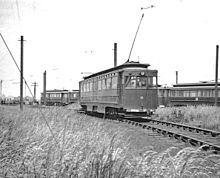Grimsby and Immingham Electric Railway
The origin of the line lay in the decision of the Great Central Railway (GCR) to build a vast new docks complex on the marshlands of the south bank of the Humber near the small settlement of Immingham.
The GCR reached agreement for the purchase of the land required and presented two Bills in Parliament of which the second was enacted as the Humber Commercial Railway and Dock Act 1904.
To facilitate construction of the docks the GDLR was initially built from the Grimsby direction as a contractors’ railway and the GCR ran a steam-hauled workmen's service on this from 3 January 1910.
For reasons not fully understood the 1913 extension joined the existing line at Immingham Town by a trailing junction, necessitating a reversal on all through journeys.
The G&IER from Corporation Bridge to Immingham Town was single track with passing loops of a standard length of 110 yards (100 m).
[15] A separate high-tension feeder on wooden poles ran alongside the line, providing current for dock operation in Grimsby.
[16][1][17] Traction power was at first supplied by two substations, transformed and converted from a 6,600 volt ac main fed from the docks generating station.
[19] The sheds were formally known as "Cleveland Bridge Works"[20] but rarely so in practice, gaining the name "Pyewipe" from nearby marshes and road on the edge of Grimsby.
[21] They did not house the cars,[22][23][24] which, unusually for British trams, spent all their life outdoors, only entering the workshop when repairs were needed.
[26] The G&IER had no physical connection with the national network apart from a right-angled flat crossing with a siding near Corporation Bridge which was unusable for interchange traffic.
When heavy repairs were needed or new trams were delivered they were craned between tramway metals and the GDLR which ran past the shed.
Four of the original cars were short-bodied,[31][32][33] intended for through operation onto the Grimsby street tramways, but the majority of the fleet, at 43 feet 8 inches (16.51 metres) overall length, were by far the largest British trams until modern times: with 72 seats, they had a larger capacity than many contemporary double-deckers.
They had a central luggage and goods compartment (known locally as "The Horse Box") and handled milk, produce, and small consignments.
After 1945 Grimsby Corporation promoted a 200-acre industrial estate west of the town and near the G&IER, and in the absence of any direct road, workers at the new factories also relied on the tramway.
To handle the extra passenger traffic British Railways acquired three single-decked bogie trams from Newcastle Corporation Transport in 1948 (the only cars on the line to have upholstered seats)[36][37][33][38][39][40][41][42] and a further nineteen were bought in 1951 from the Gateshead and District Tramways Company, which had just ceased operation (one was dropped whilst being craned into the shed during delivery and destroyed, so only eighteen entered service).
Closure of the remainder was first proposed in 1958, and a bus service commenced on 28 February 1959, worked jointly over an indirect route by Grimsby Corporation and the Lincolnshire Road Car Company.
A tram service was only retained in much curtailed form in peak periods, pending completion of a direct road to the industrial estate and the docks.
In 2017 eight characteristic pointed-topped, spun concrete masts used to support the overhead wires were still in situ by the site of Immingham Town, as was the brick bus (tram) shelter which was erected in the Second World War to replace the wooden version[44] and offer some air raid protection.










